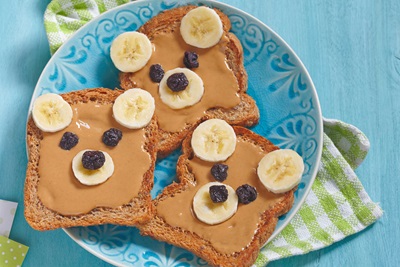As a parent, ensuring your child eats nourishing foods is one of your most important jobs. And while you may start out with the best of intentions (homemade organic baby food, anyone?) when your baby first arrives on the scene, there’s a tendency for those healthy habits to drop off as easygoing babies transform into picky toddlers and kids. In fact, according to the American Heart Association, about one in three American kids and teens today is overweight or obese, thus at greater risk for type 2 diabetes and cardiovascular disease.
Childhood is a time of rapid growth, change and development. As such, it’s critical to ensure your kids get the vitamins, minerals and nutrients their bodies need to thrive. Fall down on the job and your child may suffer from complications ranging from insufficient growth and brain development to a weakened immune system and moodiness.
Start when your child is young – even during infancy – and you may find yourself with a child who downs guacamole and hummus (like my 2-year-old does). At 9 and 10 months, I presented him with a variety of whole foods that I knew were good for him. You can accomplish the same by following these 10 strategies:

- Become a supermodel. Our kids model our behaviors. In general, they eat what we eat and follow our patterns with food. Choose healthy meals and snacks for yourself too, so kids see what you’re eating and want to imitate it. And, instead of hitting the drive-thru every night, prepare meals in advance using wholesome ingredients.
- Don’t give up. Even if your child doesn’t like a food the first time he or she tries it, don’t take it off the plate. If you only expose your baby to healthy, whole foods from the beginning, taste buds will develop to enjoy these things. Your best bet: Offer a wide variety of vegetables and fruits and introduce each at least 10 to 12 times.
- Stockpile healthy options. If your kids open the kitchen cabinets and uncover a sea of chips, candy and crackers, that’s what they’ll eat. On the other hand, if you fill your pantry with healthful staples – nuts, whole grain crackers and fruits and vegetables – they’ll eat those healthier foods instead. While there are no inherently “bad” foods, moderation and balance are critical components of healthy eating.
- Indulge responsibly. You don’t need get rid of your family’s Friday night pizza. Instead, focus on balance. Instead of letting your child chow down half a pie, serve up one or two slices of veggie pizza with healthy sides, such as carrots, apple slices and bell pepper boats.
- Get kids involved in meal prep. Kids are more likely to eat the foods you serve if you involve them in the process. So, instead of just serving up a dish you whipped up on your own, enlist your child to help with peeling vegetables, shredding low-fat cheese and layering casseroles. Even small children can take on meal preparation duties, such as setting the table.
- Hit the farmer’s market. The farmer’s market is a great way to introduce children to fruits and vegetables they’ve never tasted before. Many purveyors offer free samples of their produce. Others provide ideas for preparing their pickings that will earn kids’ seal of approval.
- Grow a garden. Kids love to watch things grow, particularly when they plant the seeds themselves. Vegetables like tomatoes, bell peppers and eggplant are relatively easy to grow, as are herbs such as basil, rosemary and mint. Not only will you teach your child healthful habits, but you’ll benefit from the fruits of your labor all year long (especially if you use your freezer!)

- Get creative. Food presentation can make the difference between a child trying a vegetable or leaving it on the plate. A surefire strategy: Dress up healthful foods so they’re more fun to eat. Make faces on whole grain pancakes by using blueberries for the eyes, a strawberry for a nose and banana slices for a mouth. Load up skewers with different types of fruit or make ants on a log (celery loaded with peanut butter and dotted with raisins).
- Create a positive food environment. Make the dinner table a no-fight zone, and don’t force your child to become a member of the “clean-plate club.” The goal is to create a healthy relationship with food, not a power struggle that you will invariably lose. Most important, don’t turn to bribery. Offering a child chocolate just to ensure he finishes his broccoli does not send a good message – or make broccoli more attractive.
- Go easy on drinks. Parents may not realize just how much milk and juice their children are drinking. Some sippy cups hold 12 ounces or more, so if you give your child two sippy cups of milk each day, you’ve already met your quota. Plus, drinks can make children feel full, leaving less room for nutrient-rich food. Encourage your children to sip water or water infusions in lieu of other beverages.
The bottom line: To ensure your child gets the nourishment he or she needs to grow and thrive, make sure you serve a variety of minimally processed whole foods, including fruits, vegetables, whole grains and lean protein. Then, fill half of the plate with produce and split the other half with equal parts whole grains and lean protein (including low-fat dairy).
.jpg?h=785&iar=0&w=1920&hash=7AD82D660EF587908B4230D22A047F5A)


